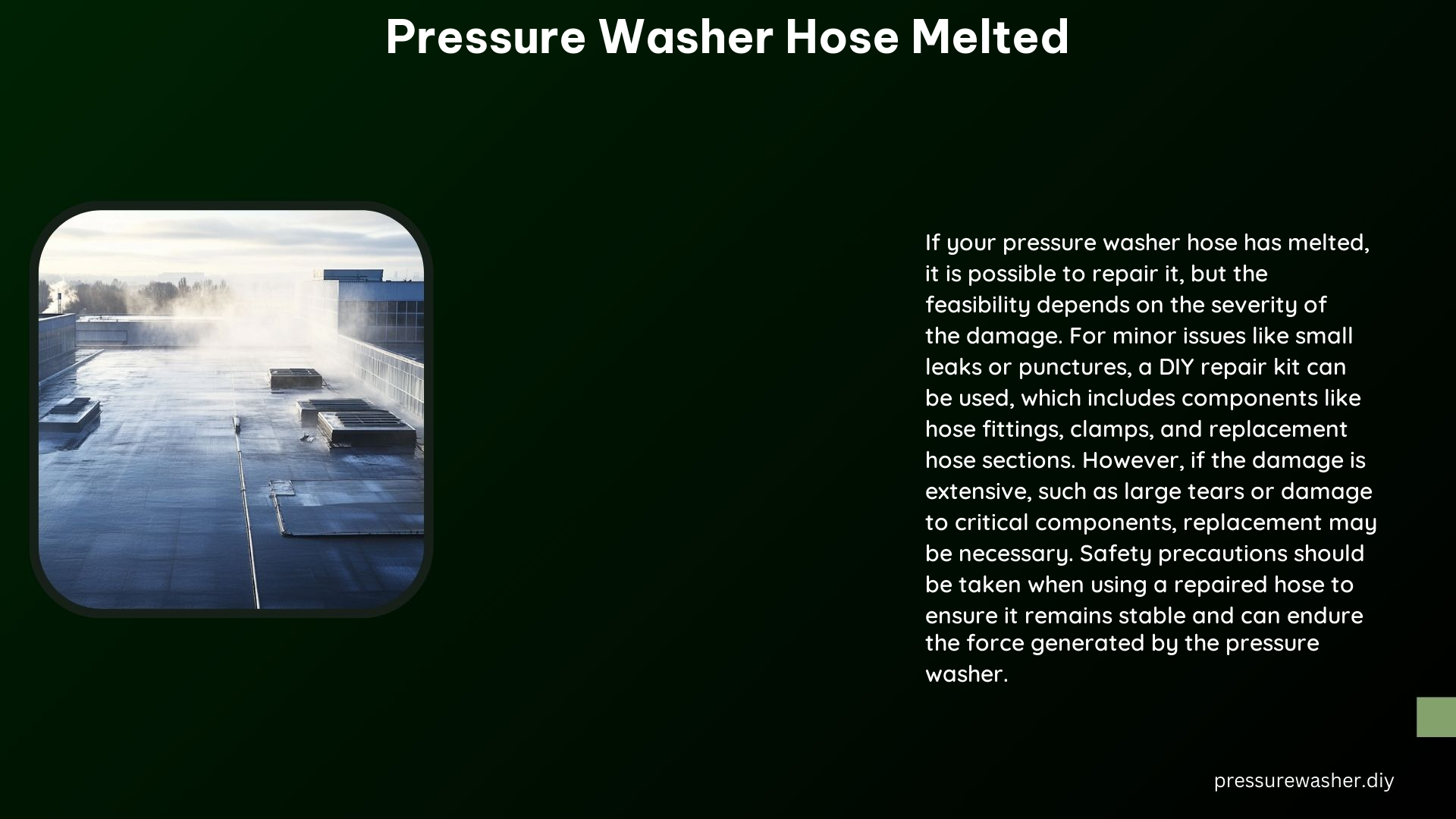If your pressure washer hose has melted, it is crucial to address the issue promptly to ensure safe and effective use of your pressure washer. This comprehensive guide will provide you with the necessary information to identify the causes, prevent future occurrences, and effectively repair a melted pressure washer hose.
Recommended PSI Rating
The recommended PSI (Pounds per Square Inch) rating for a pressure washer hose varies depending on the specific model and manufacturer. Generally, a hose with a higher PSI rating is more resistant to damage from high pressure and heat. For example, a 3000 PSI hose is more durable than a 2000 PSI hose.
The table below outlines the typical PSI ratings for pressure washer hoses:
| Hose PSI Rating | Recommended Use |
|---|---|
| 2000 PSI | Light-duty tasks, such as cleaning cars, patio furniture, and windows |
| 3000 PSI | Medium-duty tasks, such as cleaning driveways, siding, and decks |
| 4000 PSI | Heavy-duty tasks, such as stripping paint, cleaning heavy-duty equipment, and industrial applications |
It’s important to match the hose’s PSI rating to the pressure washer’s output to ensure safe and effective operation. Using a hose with a lower PSI rating than the pressure washer’s output can lead to hose failure and potential damage to the equipment.
Causes of Melting

A pressure washer hose can melt due to various reasons, including:
-
Hot Exhaust: The hot exhaust from the pressure washer’s engine can cause the hose to melt if it is not properly positioned or if the hose is damaged. The exhaust temperature can reach up to 1,000°F (538°C), which is more than enough to compromise the hose’s structural integrity.
-
Rough Handling: Improper handling, such as pulling the hose across sharp surfaces or exposing it to harsh chemicals, can lead to damage and melting. The hose’s outer layer can become worn or cracked, making it more susceptible to heat-related damage.
-
Normal Wear and Tear: Over time, the hose can weaken due to frequent use, leading to cracks or tears that can cause melting. The hose’s materials, such as rubber or PVC, can degrade over time, reducing their resistance to heat and pressure.
-
Excessive Pressure: Using a pressure washer hose with a lower PSI rating than the machine’s output can lead to hose failure and melting. The high pressure can cause the hose to rupture or deform, leading to localized heat buildup and melting.
-
Kinking or Bending: Sharp bends or kinks in the hose can restrict the flow of water, leading to increased pressure and heat buildup, which can ultimately cause the hose to melt.
Understanding the potential causes of hose melting is crucial in developing effective prevention and repair strategies.
Prevention and Repair
To prevent your pressure washer hose from melting during use:
-
Proper Positioning: Ensure the hose is kept away from the hot exhaust and any other heat sources. Consider using a heat shield or insulation wrap to protect the hose from direct exposure to the exhaust.
-
Regular Inspection: Regularly inspect the hose for signs of damage, such as cracks, tears, or worn-out areas. Replace the hose if any significant damage is observed.
-
Proper Storage: Store the hose properly when not in use to prevent damage from environmental factors, such as UV exposure, chemicals, or physical abrasion.
-
Hose Selection: Choose a pressure washer hose with a PSI rating that matches or exceeds the output of your pressure washer. This will ensure the hose can withstand the pressure and heat generated during operation.
If your hose has already melted, you may be able to repair it using a pressure washer hose repair kit. These kits typically include components like hose fittings, clamps, and replacement hose sections. DIY repair methods, such as patching and splicing, can be done with basic tools and materials.
When repairing a melted hose, it’s essential to ensure that the repaired section can withstand the pressure and heat generated by the pressure washer. Use high-quality fittings and clamps, and follow the manufacturer’s instructions carefully to ensure a secure and durable connection.
Technical Specifications
When selecting a pressure washer hose, consider the following technical specifications:
-
PSI Rating: Choose a hose with a PSI rating that matches or exceeds the output of your pressure washer. For example, a 4000 PSI hose would be suitable for a pressure washer with a maximum output of 4000 PSI.
-
Material: Look for hoses made from durable materials that can resist heat and damage, such as reinforced rubber or high-density polyethylene (HDPE). Avoid hoses made from lower-quality materials, as they are more susceptible to melting and failure.
-
Length and Diameter: Select a hose length that is appropriate for your cleaning tasks and the layout of your work area. The hose diameter should also match the pressure washer’s inlet and outlet fittings to ensure a secure and leak-free connection.
-
Temperature Rating: Consider the hose’s maximum temperature rating, which should be higher than the expected operating temperature of your pressure washer. A hose with a higher temperature rating will be more resistant to melting.
-
Abrasion Resistance: Look for hoses with a durable outer layer that can withstand contact with rough surfaces, sharp objects, and other potential sources of damage.
By carefully considering these technical specifications, you can select a pressure washer hose that is less likely to melt and will provide reliable performance for your cleaning tasks.
References
- https://www.justanswer.com/general/0oass-just-purchased-new-pressure-washer-melted-hose.html
- https://thebluehose.com/blogs/news/pressure-washer-hose-repair
- https://sawmillcreek.org/showthread.php?9923-Fixing-high-pressure-%28washer%29-hose
- https://www.youtube.com/watch?v=oxUWBZYAXaQ
- https://www.reddit.com/r/maintenance/comments/1b6eml3/pressure_washer_hose_burnt/
